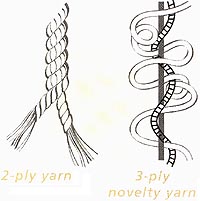|
Yarn is the medium of fabric construction. However the fabric is formed, its character is determined to a great degree by the type of yarn from which it is made. Before they are formed into yarn, fibers are referred to as either staple or filament.
|
|
Other terms are used when describing yarn. These require more complex yarn-making techniques. A mat of random fibers is first sorted, cleaned, and blended into a uniform mixture and then subjected to several procedures that align the fibers and impart twist.
(article continued below...) |
See which of our web site's "Yarn" products the popular search engines have chosen to list...
- Google listing
of all "Yarn" items on our site
- Yahoo! listing
of all "Yarn" items on our site
- Alta Vista listing of all "Yarn" items on our site
Recommended Reading
Recommended Products
Want to learn more about sewing, knitting and related arts and crafts? Browse our reading list.
If you need specific fabric supplies, have a look at these pages:


Yarn as it comes from the original spinning frame is called a single. Twisting several singles together produces a ply yarn and improves uniformity and strength. The character of a yarn is also influenced by the degree of twist. Low-twist yarns, soft and relatively weak, are used for napped fabrics. Higher twist increases strength and crispness. Very high twist is used for crepe effects, as the tension causes puckering.
COMPLEX OR NOVELTY YARNS include several types, most of which are produced primarily for appearance value since they are seldom strong. They may be single or ply, and often contain components of several colors or fiber types for visual variations. Slub yarns or novelty single yarns, vary along their length in thickness and amount of twist. The typical novelty ply yarn generally is composed of a strong base yarn that forms the support and determines the length, combined with an effect yarn that is held in place by a binder. Examples of this type are bouclé, ratiné, spiral and knot yarns.
TEXTURED YARNS are produced from man-made fibers that possess the useful characteristics of thermoplasticity, which means they will melt when subjected to heat. Through the use of this property, filament yarns can be heat-set in interesting textured effects. Several manufacturing methods can change the contour of the filament to a coiled, crimped or looped formation from its original rod-like shape. Yarns from such filaments may be lightweight, have great bulk, or have a high degree of stretch.
